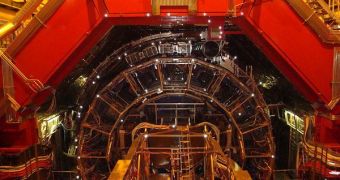Scientists at the CERN-operated Large Hadron Collider (LHC) have proudly announced the first scientific results from the world's largest physics experiment and particle accelerator. They publish the first study based entirely in the observations carried out at the Collider, on two opposite beams of protons, which continuously collide in the 27-kilometer-long tunnels underneath Geneva. The first-ever paper of the LHC team appears online in the European Physical Journal C, AlphaGalileo reports.
The accelerator has had a long way to go to get here. Originally scheduled to be commissioned in September 2008, it suffered a massive glitch just a few days into its operation phase, and needed to be shut down for maintenance. It was only recently reopened, and it, only a few weeks ago, it broke the world record for the most powerful particle smasher ever. Now, with new safeguards set in place, everything appears to be running smoothly inside the $10-billion project.
The commissioning of the instrument took place on November 23, when the first proton beams were injected in the tunnels, at their designed energy of 450GeV per beam. By 2011, the energy for each individual beam needs to climb as high as 7TeV, for a total combined power of no less than 14TeV. This is estimated to be well within the energy range of the elusive Higgs boson, the elementary particle that is to complete the Standard Model, when found. Particle physicists believe that it is responsible for turning energy into matter, and have therefore dubbed it “God's particle.”
In the new study, more than 284 collisions took place in the ALICE (A Large Ion Collider Experiment) instrument on the LHC, one of four massive particle detectors scattered around the tunnels. The team operating the instrument was able to determine the pseudorapidity density of the scattered beams, which is the average number of charged particles emitted perpendicular to the beam's own direction. The new study is important because it provides the experts with a way of establishing a reference for future collision results, through measurements of proton-antiproton interactions.
Results thus far are in tune with previous observations of the same set of phenomena, the ALICE group reports. “This important benchmark test illustrates the excellent functioning and rapid progress of the LHC accelerator, and of both the hardware and software of the ALICE experiment, in this early start-up phase. LHC and its experiments have finally entered the phase of physics exploitation,” CERN and ALICE spokesperson Dr. Jurgen Schukraft says.

 14 DAY TRIAL //
14 DAY TRIAL //